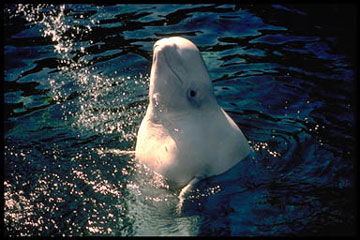 December 04, 2006
"We expected the Cook Inlet beluga population to start growing at two to six percent per year when unregulated hunting stopped in 1999," said Dr. Doug DeMaster, Administrator of the Alaska Fisheries Science Center. "That hasn't happened. A population viability analysis indicates that the likelihood of this population going extinct within the next 100 years is significant unless factors determining the population's growth and survival are altered." The status review is one part of a larger effort that began in March 2006 to determine whether the Cook Inlet population should be listed as threatened or endangered under the Endangered Species Act. In April 2006, NOAA Fisheries received a petition from Trustees for Alaska to list Cook Inlet belugas as endangered under the Endangered Species Act. In August, the agency announced that the petition presented substantial scientific or commercial information indicating that the petitioned action may be warranted. Within 12 months of the date of such a petition, NOAA Fisheries must make one of the following findings:
The goal of the recently-completed status review is to provide a summary of the best available science to aid NOAA Fisheries policy makers with decisions about the status of the Cook Inlet beluga whale population and possible listing under the Endangered Species Act. The agency reviewed the Cook Inlet beluga population earlier and, in 2000, determined that a listing under the Endangered Species Act was not warranted. The population was designated as depleted under the Marine Mammal Protection Act at that time. The Cook Inlet beluga population is a discrete and unique population of 'Delphinapterus leucas', one of five beluga stocks (Cook Inlet, Bristol Bay, eastern Bering Sea, eastern Chukchi Sea, and Beaufort Sea) recognized within U.S. waters. Researchers estimate a population of about 60,000 belugas in Alaskan waters outside Cook Inlet. The Cook Inlet beluga stock is estimated to have numbered more than 1,300 belugas as recently as the 1970's. The 2005 abundance estimate for the Cook Inlet population is 278 belugas. The number of Cook Inlet belugas declined nearly 50 percent between 1994 and 1999. Beluga hunting restrictions were enacted in 1999. NOAA Fisheries has worked with the Cook Inlet Marine Mammal Council, the Native Village of Tyonek, Cook Inlet Treaty Tribes and others during the last decade to establish co-management agreements for these belugas. Between 1999 and 2006 five whales were taken for subsistence in Cook Inlet. The Cook Inlet belugas have contracted their range northward into upper Cook Inlet, making the concentrated population more vulnerable to catastrophic events which have the potential to kill a significant fraction of the remaining population, according to the status review. The Cook Inlet belugas are dependent on salmon runs in the Inlet, gaining much of their annual nutrition during the summer months.
On the Web:
Source of News:
Publish A Letter on SitNews Read Letters/Opinions
|
||
